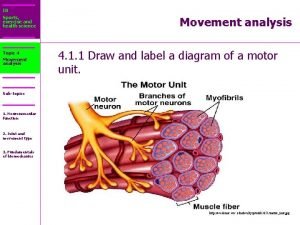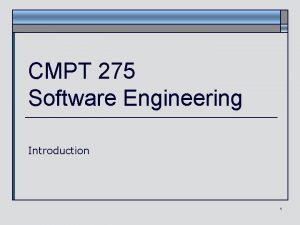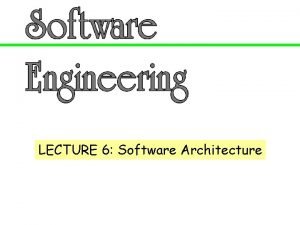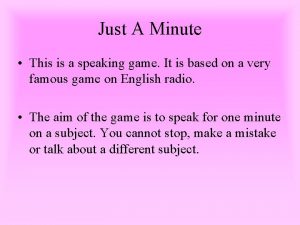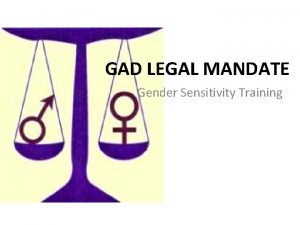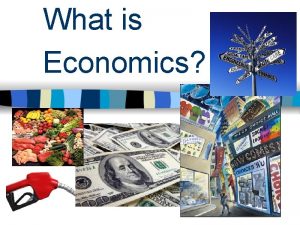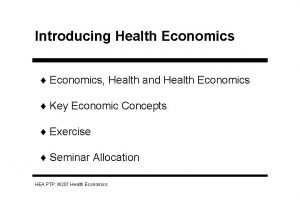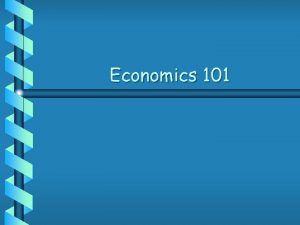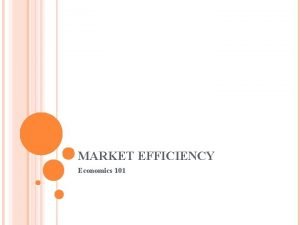Week 8 Economics Topics of Week 8 1









































- Slides: 41

Week #8 Economics

Topics of Week #8 1. Composition and Equation of GDP* 2. Nominal vs. Real GDP* 3. Equation of Real GDP* "*" Indicates the most important topics. Mateer and Coppock: Chapter #19

Introduction to Macroeconomics


Misconception • Misconception: There is no reliable way to determine how well an entire economy is performing. – Economists disagree whether our economy is good or bad, whether it is getting better or worse. • However, there is an objective and reliable measure of macroeconomic performance—and it is Gross Domestic Product (GDP).

Defining GDP • Gross Domestic Product – The market value of all final goods and services produced in a nation within a specific period of time. – Functions as a "barometer" for the economy. – Sum of output from all economic activity. – Output (sometimes Expenditure) becomes income. Output (Expenditure)= GDP = Income

Production Equals Income • Output (sometimes Expenditure) and income are essentially the same. – Nations that produce a large amount of highvalue output are relatively wealthy. – Nations that don't produce much high-value output are relatively poor. – Idea: the output you produce is sold, and you receive income for what you sell.

Looking Closely at How We Measure GDP • Why does GDP count the "market value"? – We can't just count quantities. Look at the year 2010. – United States produced 12 billion bushels of corn. – United States produced 8 million cars. – Just looking at quantity-produced numbers, corn seems more "important" to our GDP relative to cars.

Looking Closely at How We Measure GDP Quantity x Price = Market Value Corn 12 billion bushels x $5 = $60 billion Cars 8 million vehicles x $30, 000 = $240 billion $300 billion

Looking Closely at How We Measure GDP • Why does GDP include both goods AND services? – Goods • Tangibles • Food, clothing, cars, houses – Services • Intangibles • Health care, entertainment, advice, travel, banking – The composition of our industries and economy has greatly changed over the last 50 years.

Services as a Share of U. S. GDP

Intermediate vs. Final Goods • Final goods – Goods sold to the final users, or consumers. • To get an accurate GDP estimate and avoid double counting. – Finals goods are included in GDP. – Intermediate goods are not.

Intermediate Steps in Cell Phone Production Steps 1. Outer case and keyboard 2. Internal hardware 3. Install operating system 4. Connect to network 5. Retail sale Sum total Value added during step Price of completed steps $ 5 10 15 49 120 $ 5 15 30 79 199 $398

Looking Closely at How We Measure GDP • Why does the definition of GDP include the word "produced"? – Has to do with double-counting again. – Don't want to recount a good that was produced last year. – Examples: • Don't count a resold used car. • Stocks and bonds sold do not count, except for fees that pay for service.

Included vs. Not Included in GDP • The cars produced in a Japanese-owned Toyota factory located in Kentucky in 2013 Is it included in US or Japan GDP of 2013? The following items are not included in GDP: • Sales of intermediate products. • Sales of used goods. • Purely financial transactions. • Nonmarket activities. • Imported products and services. • Increases in the value of existing assets. • The underground economy.

Looking at GDP as Different Types of Expenditures • The Bureau of Economic Analysis (BEA) is the U. S. government agency that tallies GDP data, a task is called national income accounting. GDP = C + I + G + NX Net Exports Consumption Investment Government Purchases

The Pieces of GDP in 2010, Billions of Dollars Consumption (C) Durable Goods Nondurable Goods Services Investment (I) Business Fixed Investment Residential Construction Change in Business Inventories Government Purchases (G) Federal State and Local Net Exports (NX) Exports Imports Total GDP $10, 245. 5 71% 1, 795. 1 12% 3, 002. 8 21% -516. 9 -4% $14, 526. 5 100% $1, 085. 5 2, 301. 5 6, 858. 5 1, 728. 2 338. 1 66. 9 1, 222. 8 1, 780. 0 1, 839. 8 2, 356. 7

Consumption • Consumption – Final purchase of goods and services by households, with the exception of new housing. Generally, consumption is the largest component of GDP. • Durable goods – Goods consumed over a long period of time – Cars, appliances – Subject to cyclical fluctuations • Nondurable goods

Investment • Investment – Private spending on tools, factories, and equipment used to produce future output. – Also includes purchases by businesses that add to their inventories. • Inventories represent a stock of goods that firms can use to produce their product in the future. An increase in inventory allows the firm to make more and is an investment for the future. – New house purchases by consumers are counted as investment. – Investment is NOT "investing" in stocks and bonds.

Government Purchases • Government Purchases – Government employee salaries – Government buildings and equipment produced – Public works projects, national defense, schools, post offices • Does NOT count – Transfer payments, such as welfare or social security – When households spend this income, it will enter GDP as part of consumption or investment.

Net Exports • Net Exports (NX) – Exports subtract imports. • If imports > exports → NX < 0 → Trade Deficit • If exports > imports → NX > 0 → Trade Surplus – NX represents a small fraction of total GDP. • Is it bad to be in a trade deficit? – Not necessarily – More imports means more goods and services for people in this country

Shortcomings of GDP The followings are not counted in GDP: • Nonmarket goods • Underground economy • The Quality of the Environment • Leisure time

Economics in Superbad • "Superbad" – Underground economy

Real GDP: Adjusting GDP for Price Changes • Real GDP – GDP measured with prices held constant over time. • Nominal GDP – GDP measured current prices. • Price level – An index to measure prices of goods and services in an economy. – Consumer Price Index (CPI) and GDP Deflator indicates price level. – The difference is the composition of goods they consider.

Real GDP: Adjusting GDP for Price Changes • CPI – Includes only a standard market basket of goods and services purchased by a typical urban family, not all final goods and services. – For calculation of Inflation, we have to use CPI. – We will come back to CPI later. • GDP deflator – A measure of the price level that includes prices of final goods and services in GDP. – Used to "deflate" out inflation from nominal GDP. – GDP deflator is a measure of price level used only for Real GDP calculation. – Don't worry about calculating GDP Deflator, it will be given to you.

U. S. Nominal GDP and Price Level, 2000– 2010 Year Nominal GDP (billions of dollars) Price Level (GDP deflator) 2000 2001 2002 2003 2004 2005 2006 2007 2008 2009 2010 $9, 951. 5 10, 286. 2 10, 642. 3 11, 142. 2 11, 853. 3 12, 623. 0 13, 377. 2 14, 028. 7 14, 291. 5 13, 939. 0 14, 526. 5 88. 7 90. 7 92. 2 94. 1 96. 8 100. 0 103. 2 106. 2 108. 6 109. 7 111. 0 Source: BEA 2005 is the base year, so Price level for 2005 is 100.

U. S. Nominal and Real GDP Which year is the base year here? Can you tell by only looking this plot?

Finding Real GDP 1. Filter out the current prices from the nominal GDP data. – Divide nominal GDP by the price level for the year the GDP was produced. 2. Put in the constant prices from the base year. – Multiply by the price level (100) from base year 2005.

Example • Find Real GDP for 2010. – "2010 GDP in 2005 prices" – Fill in equation, use t = 2010 numbers from table.

Growth Rates • Growth rates – – Tell us how fast our economy is growing. Can be calculated using a percent change formula. A negative growth rate means the economy is contracting (recession). Caveat: We care only Real GDP Growth Rate since Nominal GDP Growth Rate can be misleading due to increase or decrease in price level.

Growth Rates • Using the numbers from the table again.

Growth Rates • Price level growth rate – The same as the GDP deflator growth rate. • Another useful evaluative formula

Conclusion • Determining how much output is produced in the economy gives a benchmark from which to examine economic growth and fluctuations in economic activity. • Measuring GDP allows us to examine economic output across countries.

Practice What You Know Gross domestic product (GDP) also measures A. B. C. D. A nation's exports. A nation's debt. A nation's income. A nation's consumption.

Practice What You Know Why does not GDP count expenditures on intermediate goods? A. To make GDP calculations easier B. Because intermediate goods are used by firms instead of consumers C. To avoid double counting D. Intermediate goods have no market value

Practice What You Know What is the biggest component of GDP? A. B. C. D. Consumption [C] Investment [I] Government Purchases [G] Net Exports [NX]

Practice What You Know Which of the following would not be included in GDP? A. Bob hires a construction company to build his home B. Michael pays the neighbor kid to mow his yard C. Alex buys some cheese and dough to bake a pizza at home D. Elyse buys some shoes

Practice What You Know How is real GDP different from nominal GDP? A. Real GDP is adjusted for inflation, and nominal GDP is just measured in current prices. B. Real GDP includes goods and services, and nominal GDP only includes goods. C. Real GDP averages income over time, and nominal GDP is just for this year.

Practice What You Know • Fill the blanks.

Practice What You Know

Sources • "Principles of Economics with Smartwork Access (ISBN: 978 -0 -26314 -5), 1 st Edition, 2013" by Mateer and Coppock • "Economics: Custom Edition for NCSU (ISBN: 9781937435202" by David Hyman
 Business economics topics
Business economics topics Non mathematical economics
Non mathematical economics School of business and economics maastricht
School of business and economics maastricht Week by week plans for documenting children's development
Week by week plans for documenting children's development Topics vs themes
Topics vs themes Ib sehs topic 4
Ib sehs topic 4 Software engineering important topics
Software engineering important topics Software architecture topics
Software architecture topics Theme of things fall apart
Theme of things fall apart Uil extemp topics
Uil extemp topics Avertica
Avertica Hima lakkaraju
Hima lakkaraju S-p-s-e structure
S-p-s-e structure Special topics in software engineering
Special topics in software engineering How to write an essay grade 9
How to write an essay grade 9 Nonverbal communication topics
Nonverbal communication topics Hr meeting agenda topics
Hr meeting agenda topics Just a minute game
Just a minute game Bondservants motorcycle
Bondservants motorcycle Engineering meeting topics
Engineering meeting topics Individual oral presentation topics
Individual oral presentation topics Philosophical chairs questions
Philosophical chairs questions Android advanced topics
Android advanced topics Data warehouse research topics
Data warehouse research topics Classification and division
Classification and division Travel histology jobs
Travel histology jobs Conclusion of csr
Conclusion of csr Scala topics
Scala topics August safety topics
August safety topics Sociolinguistics topics for presentation
Sociolinguistics topics for presentation Thank you for listening
Thank you for listening Decision briefing
Decision briefing Group discussion tips in tamil
Group discussion tips in tamil Spring safety topics
Spring safety topics Wireless communication research topics
Wireless communication research topics Bad news letter topics
Bad news letter topics Sample of expository paragraph
Sample of expository paragraph Http //vsg.quasihome.com
Http //vsg.quasihome.com Catcher and the rye themes
Catcher and the rye themes Act writing prompts
Act writing prompts Ancient greece essay topics
Ancient greece essay topics Hosa extemporaneous health poster
Hosa extemporaneous health poster





